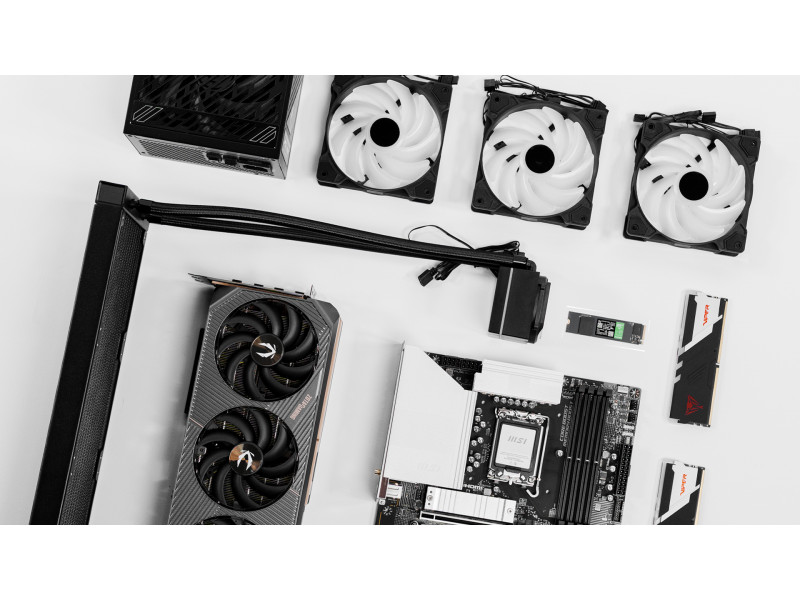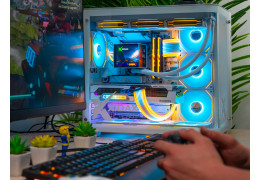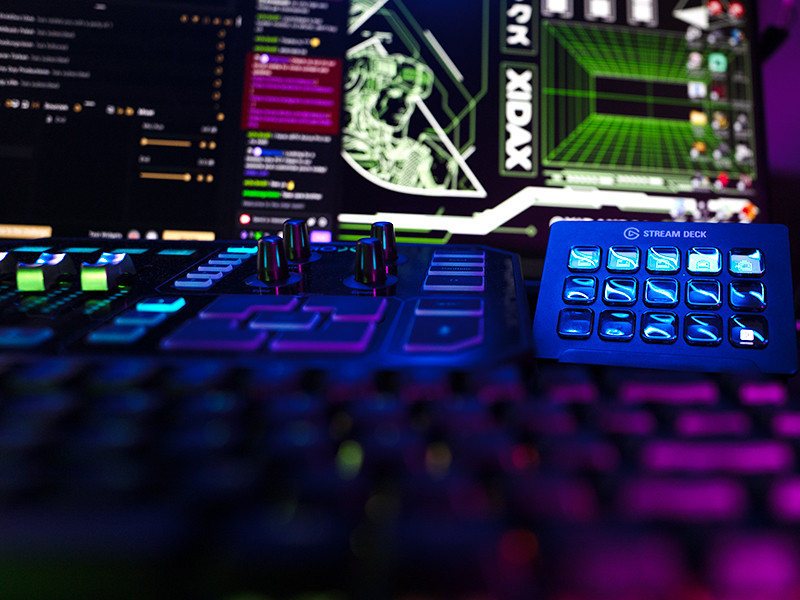
The Silent Gaming Revolution: How to Build a Quiet Gaming PC Without Sacrificing Power
Everyone loves a high-performance gaming PC; the kind that crushes the latest AAA titles or chews through heavy workloads without breaking a sweat. Historically, the trade-off for that power was noise. We all know the jet-engine whir of gaming rigs under load. But times have changed. A silent gaming PC truly offers the best of both worlds: blistering performance and a peaceful, quiet experience.
In this guide, we at Xidax want to share how we build powerful yet whisper-quiet custom gaming PCs and workstations, and how you can do the same. We'll cover quiet gaming PC components, design strategies, and practical tips – whether you're planning a brand-new silent gaming PC build or upgrading an existing rig for tranquility. By the end, you'll see that you don’t have to sacrifice power to build a quiet PC, and why Xidax PCs are a one-stop solution for performance builds that barely make a peep.
Understanding PC Noise
Building a quiet PC isn’t just about comfort (though not sounding like a hair dryer is a huge plus). It’s also about creating a distraction-free environment for gaming, streaming, or working. No one wants fan roar ruining an immersive game or buzzing in the background of a live stream.
The good news is that today’s technology lets us tame the noise without throttling performance. Modern components are more power-efficient (meaning less heat to deal with), and cooling solutions have evolved to be both high-performance and low-noise. In fact, some experts consider anything under ~40 dBA to be “silent,” and quality cooling parts can keep noise well below that even under load . This quiet revolution is built on a few key principles that we’ll explore:
- using efficient cooling at lower speeds
- choosing components designed for low noise
- damping any remaining sound
What makes a PC loud in the first place?
Primarily, it's moving parts: fans on your CPU cooler, GPU, case, and power supply, plus any mechanical hard drives or pump noise if you have liquid cooling. High heat output from powerful CPUs/GPUs traditionally meant those fans had to spin like crazy – generating a lot of noise – to keep components cool. But our philosophy is simple: overbuild your cooling and slow down your fans.
By using beefier coolers and more (or larger) fans than strictly needed, we can run everything at a lower RPM for the same cooling effect, dramatically reducing noise. In other words, excess cooling capacity = fans barely have to work = quiet operation.
Modern GPUs and CPUs also offer features to help silence things when full power isn’t needed. Many graphics cards now have semi-passive cooling: their fans shut off completely at idle or low load (often called “0 dB mode”). This means your gaming PC can be silent when you’re not gaming – no more constant background hum. And when you do fire up a game or intensive task, a well-designed quiet build will only ramp up cooling as much as needed, using smart fan curves and efficient heatsinks so that even under load the sound is a gentle woosh, not a scream.
What Hardware Do I Need to Build a Silent Gaming PC?
First, let’s bust a myth: achieving a near-silent PC does not mean you have to settle for mid-tier hardware or cap your performance. With careful component selection and tuning, you can run top-of-the-line CPUs and GPUs in near silence. In fact, we’ll cite some benchmarks and real-world tests along the way to prove it. The bottom line is, silence is now a feature you can build for, just like frame rates or render times, and Xidax specializes in delivering that no-compromise experience.
Build a Silent Gaming PC: Key Components and Strategies
Building a silent powerhouse starts with choosing the right components and design approach. Let’s break down the main areas and how we tackle each for a quiet gaming PC build:
1. CPU Cooling: Air vs. Liquid – The Silent Cooling Showdown
Keeping your CPU cool under heavy loads is crucial, but it’s also one of the biggest sources of noise. The two main options are air coolers (heatsink + fan combos) and liquid coolers (AIO closed-loop systems or custom loops with radiators). Both can be part of a silent cooling strategy if done right, but we often favor high-end air coolers for the quietest builds. Why? Two reasons: no pump noise at all, and the ability to use extra-large fans.
What about liquid cooling? AIO liquid coolers can handle high thermal loads and sometimes give you lower peak CPU temps, but they involve a pump (which can introduce a constant hum or buzz) and usually multiple radiator fans. That said, not all AIOs are loud – the trick is using a larger radiator (280mm or 360mm) with high-quality fans and possibly running the pump at a lower speed. The goal is to have those radiator fans spinning under ~1000 RPM most of the time, because above ~1000 RPM you hit diminishing returns and rapidly increasing noise.
In our shop, we’ve found a 360mm radiator with at least three 120mm or 140mm fans at 700–800 RPM can cool an overclocked CPU almost as well as fans screaming at 1500 RPM – but at a fraction of the noise. We’ll only push those speeds (or a pump’s maximum) during stress tests; day-to-day, our fan curves prioritize silence until it’s absolutely necessary.
Ultimately, both air and liquid can be viable for a silent build, but we lean toward air for top-tier quiet builds unless the absolute hottest, highest-wattage CPUs demand liquid. And even then, we design the loop for low noise.
Pro Tip: Don’t overlook thermal paste and mounting pressure – a properly seated cooler with a good paste improves heat transfer so fans don’t have to work as hard. It’s a small detail, but everything counts when chasing silence.
2. GPU Strategies: Cool, Quiet, and Powerful
Today’s graphics cards are performance beasts, but they can also be some of the loudest components when running full tilt. The key to a quiet GPU is twofold: selecting a model with excellent cooling and tuning how hard you let it work. We partner with top GPU brands like NVIDIA, ASUS, MSI, and AMD because their cooler designs are usually a cut above reference models in both temperatures and acoustics. For example, many ASUS ROG Strix and TUF series cards feature triple-fan heatsinks that are overbuilt for silence – they often run fanless at idle (0 dB mode) and only ramp up under load, and even then their large heatsinks mean the fans can spin slower for a given temperature. Whatever Model you select, choosing a card with a robust, efficient cooler design pays dividends in noise reduction.
We make sure any GPU in a Xidax quiet build has a proven low-noise cooler. That might mean a card that takes up 2.5 or 3 slots with a big heatsink (the larger surface area and more heatpipes, the better for cooling at low fan speeds). Another trick we sometimes recommend is undervolting the GPU or slightly limiting its peak power. Modern NVIDIA and AMD GPUs are so powerful that you can often shave off 5-10% of power (and heat) for only a 1-3% performance loss – a trade that results in dramatically cooler and quieter operation. Lower heat means the GPU’s fans might never ramp to audible levels even in long gaming sessions. We’ll typically recommend a mild undervolt or a custom fan curve in software so that the GPU only ramps up when absolutely needed, keeping it silent in less demanding games or workflows.
Finally, for the ultimate in GPU silence, there’s water-cooling or hybrid cooling. A custom water-cooled pc with a large radiator can be extremely quiet, but custom loops are an advanced route (and a Xidax speciality if you want it turnkey). Even then, we still rely on those same principles: big radiators, slow fans, and quality pumps (or even passive cooling in rare cases) to ensure minimal noise. Unless you’re chasing record overclocks, though, an air-cooled GPU with a top-notch heatsink should suffice for a near-silent build. Remember, most high-end GPUs today feature 0 RPM fan modes below ~50°C – meaning when you’re not in a game, your GPU makes zero noise. And when you are gaming, if you’ve picked a card known for good acoustics (or had us pick it for you!), you’ll likely never hear it over a whisper of airflow.
3. Case and Fans: Airflow Meets Acoustic Insulation
The case is literally the home for all your components, and it plays a major role in a quiet build. We like to think of it as the noise shell: it can either amplify sounds (thin, rattly cases with poor airflow will have you hearing every fan spin-up), or it can dampen and diffuse them to virtual silence. For a quiet build, prioritize cases that have good airflow paths AND built-in sound-dampening features. A case with rubberized feet, padded PSU mounts, and HDD trays will prevent even minor vibration noises from resonating.
Equally important are the case fans. Case fans maintain airflow through your PC, which you need even with the best coolers. But not all fans are created equal when it comes to noise. Airflow is the friend of silence – the easier it is for air to flow through your case (thanks to spacious layouts, mesh vents, and more/larger fans), the less each fan has to work (hence less noise). So don’t choose a tiny cramped case for a silent high-performance build; give your components room to breathe.
One more thing: using rubber mounts or grommets for fans can eliminate a lot of the subtle vibrations that cause noise. Many quiet-optimized fans include rubber pads on their corners. These absorb the vibrations instead of letting them transfer to the case body and create an audible buzz. It’s a small detail that helps keep the overall noise signature low and free of annoying rattles or resonant tones.
4. Power Supply and Storage: The Silent Support Cast
Supporting components can be silent heroes too. The power supply (PSU) has a fan, and if you choose poorly, it can be an unwanted noise source. Many quality PSUs won’t turn their fan on until you exceed ~40% load. So if you have, say, an 850W PSU and your system is idling or doing light tasks at 100-200W, the PSU fan stays off – total silence from the PSU. When it does turn on, a well-designed PSU will start the fan very slowly and often you’ll never notice it over the case fans. It’s one of those “invisible” features that you’ll appreciate when you realize your PC is on but you can’t hear the power supply at all.
If you’re going for the ultimate quiet build, there are even fanless PSUs (typically up to ~500W–600W) that use only passive cooling. These are niche, but in special workstation builds we’ve used them for absolutely silent operation (they rely on the fact that at high efficiency and lower wattage, a PSU can dissipate heat through its heatsinks alone). For most, a semi-fanless standard PSU is more than enough.
Storage is another area to consider. Traditional hard disk drives (HDDs) have moving parts (spinning platters and moving heads) which can create a constant whir and occasional clicking noises. In a silence-focused build, it’s often worth using solid-state drives (SSDs) exclusively, since they have no moving parts and operate in complete silence. If you need large capacity storage for a media library or backups, you can use 2.5" SATA SSDs or M.2 NVMe SSDs – now that multi-terabyte SSDs are more affordable, many of our clients opt to eliminate mechanical drives altogether. The difference is night and day – no spin noise, no seek clicks. And as a bonus, you get the speed of SSDs.
Beyond fans and drives, there is one more gremlin to address: coil whine. This is a high-pitched electronic noise some components (GPUs, PSUs, sometimes motherboards) can emit when power draw is high or fluctuating. Coil whine isn’t loud in a dB sense, but it can be an irritating sound for those with sensitive ears. Unfortunately, it’s somewhat a silicon lottery – some GPU models or PSU units have it, others don’t, and it’s not always advertised. While you can’t “build it out” completely, we at Xidax do our best to minimize coil whine issues by using quality components and testing our builds under load. We also find that limiting excessive FPS in games (e.g., using V-sync or frame limiters) can greatly reduce coil whine, since the GPU isn’t pushing absurd frame rates that make power coils sing. It’s a bit beyond the scope of this article, but we mention it because a truly silent PC experience means addressing even these subtle noise sources. The good news is that in a properly assembled quiet system with good cooling, you’ll rarely hear coil whine – it tends to be masked if fans aren’t blasting, and often the worst whine happens at hundreds of FPS (which you can cap).
Upgrading an Existing PC for Silence
What if you already have a powerful gaming PC or workstation, but it’s just too loud? You might not need a whole new system – a few strategic upgrades can turn a roar into a purr. Here are some practical steps, many of which echo what we’ve discussed:
Upgrade Your Fans:
Swap out any cheap case fans (or loud stock CPU/GPU fans if possible) for reputable quiet PC fans. If your CPU cooler is stock (e.g., the stock AMD or Intel cooler), consider upgrading to an aftermarket cooler with a bigger heatsink and quieter fan. Even a mid-range cooler can make a world of difference in noise when the CPU is under load. Don’t forget to configure your fan curves in BIOS or software so that fans don’t ramp up to 100% unless truly necessary.
Optimized Cooling Solutions: Airflow and Cable Management
Make sure your case has good airflow. If it’s a very compact case with limited fan mounts, consider moving to a larger case that supports more or bigger fans. You can also simply add more case fans (in a balanced intake/exhaust configuration) so each can run a bit slower. Clean up your cable management to reduce obstructions, and ensure filters are dust-free (dust buildup makes components run hotter and fans work harder). If you have an older GPU that runs hot and loud, you might look into aftermarket GPU coolers or even a DIY fan mod – there are kits to mount larger 120mm fans onto GPUs after removing the stock cooler shroud, which some enthusiasts have done for a nearly silent graphics card. This kind of mod is advanced, but it shows what’s possible.
Undervolt and Underclock:
As mentioned earlier, a mild undervolt on your GPU and/or CPU can significantly reduce heat output and fan noise, often with minimal impact on performance. Most modern motherboards and graphics card utilities (like MSI Afterburner or AMD/NVIDIA control panels) allow undervolting or setting lower power targets. By experimenting with these, you might run your GPU at 90% power, for example, which could drop temperatures by several degrees and make the fans barely audible while only costing a few FPS. We’ve seen cases where running a high-end GPU at 80% power reduced noise so much that the user never noticed the difference in performance during gameplay – the experience felt better because the PC was quiet and non-distracting.
Add Sound Damping:
If you can’t change your case, you can still add acoustic insulation to it. Kits like AcoustiPack foam or even DIY self-adhesive sound dampening sheets can be cut and placed on the side panels, top, and front interior of your case to absorb noise. Just be careful not to cover any ventilation areas or trap heat in components. Stick the foam on large flat panels that tend to vibrate or act like speaker diaphragms. Even a thin layer can help muffle the higher-pitch fan noises. Some case manufacturers sell upgrade kits. Also, consider using rubber washers/grommets on any hard-mounted drives or fans if they’re not already vibration-isolated.
Replace Loud PSUs or GPUs:
If your power supply’s fan is always on and loud, it might be an older or lower-efficiency model. Upgrading to a modern PSU with a silent mode (like those Corsair RM/HX series we mentioned, or Seasonic Focus series) can remove that noise completely. Similarly, if your GPU is an older reference card known for noise, you could consider upgrading to a newer model or a custom-cooled variant. This of course is a bigger expense, but it comes with performance gains too. Many of our customers upgrade from, say, a blower-style GPU (which are notoriously loud) to a custom dual- or triple-fan card and are shocked at how much quieter and faster the system runs.
The Xidax Advantage: Custom Quiet Gaming PCs and Workstations
We’ve walked through the components and techniques that make up a silent high-performance build. If it sounds like a lot of careful planning and tweaking – well, it is. This is where we humbly plug Xidax’s custom PC building services. Because we live and breathe this stuff, our team knows exactly which parts play nicest together for a quiet PC and how to tune them just right. When you order a custom Xidax gaming PC or workstation, you can opt for our prebuilt gaming PCs, or customize your own quiet pc build. The result is a machine that arrives on your doorstep already whisper-quiet out of the box, but still packing the full punch of whatever CPU/GPU you requested. We run burn-in tests on every build, measuring thermals and noise, so we know your system won’t just be quiet at idle but also under full load.
Another benefit of trusting Xidax: we handle the little details like proper cable management (improving airflow), and BIOS fan tuning. Our philosophy is that a truly high-end PC isn’t just about raw FPS or benchmark numbers; it’s about the overall experience. A quiet gaming PC that still delivers sky-high frame rates and snappy performance enhances your experience – you get to be immersed in the game or focus on your work, rather than being reminded there’s a machine chugging away next to you. And for professionals using our workstations in studios or offices, the low noise can literally be a productivity boost (or for content creators, it means your microphone isn’t picking up fan noise during recordings or streams).
Conclusion: Embrace the Quiet Revolution
The era of needing a loud, power-hungry box to get top-tier gaming or workstation performance is over. A new era – a quiet revolution – is here, where silent gaming PCs are not only possible, but increasingly common for those of us who value our ears as much as our frame rates. By carefully selecting components like quiet fans, oversized coolers, efficient GPUs/CPUs, and sound-damped cases, and by leveraging techniques like fan curve optimization and undervolting, you can build a PC that’s nearly silent without sacrificing an ounce of power.
If you’re DIYing, hopefully this guide serves as a practical roadmap – from the big decisions (air vs liquid cooling, which case to use) down to the small tips (use rubber mounts, clean those filters, etc.). And if you’d rather skip straight to gaming on a silent powerhouse, the Xidax team is ready to build your dream rig. We take pride in crafting machines that impress not just in benchmarks but in everyday enjoyment. After all, the ultimate test of a high-performance quiet PC is forgetting it’s even there – letting you get lost in the game or workflow with zero distractions. That’s the quiet revolution we’re all about, and we invite you to join it.
Ready to get building?
- Check Out Our Pre-built PCs
- New to Customizing? Try Our Easy Mode PC Builder
- Ready to Build Your Dream Gaming PC? Take a Look at Our Latest Customizable Gaming Rigs


